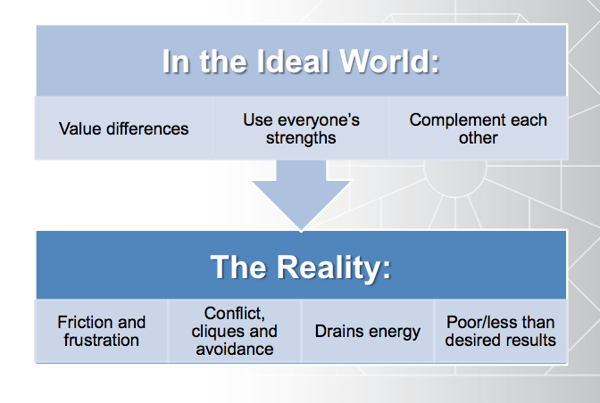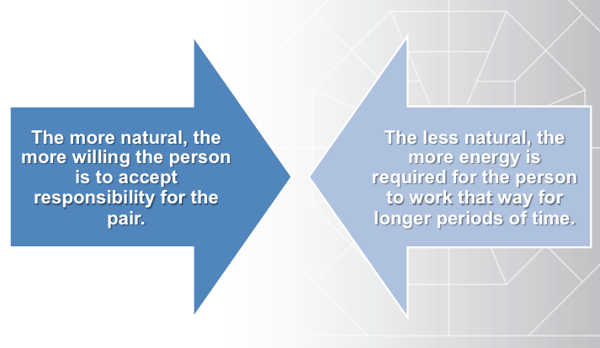Managers use the Work Pair Assessment to better connect with their individual team members.
Managing people, our most valuable asset, can be challenging. Issues arise when our communication styles differ. Hence, managers are asking us for more tools to add to their manager's toolbox. The Work Pair is one tool that we can easily add. Today we'll be highlighting a few sections of the Work Pair Assessment to get you started.
Ideal vs. reality

In an ideal world we wouldn’t have conflicts right? We’d value each other’s differences, use everyone’s strengths, and work fluidly as a team. We would know when to modify our behaviors. However, the reality is that friction and frustration are a part of our human experience. For example, new employees may notice there are certain groups or cliques that exists in your team; certain DISC styles naturally gravitate to each other because they are similar, but at the same time exclude others. The new employee may find this off-putting and avoid the group; thus widening the gap between team members. Managers may find certain team members more challenging because they don't seem to understand each other.
Relationships with people who are different from us take energy and can cause frustration. We may even avoid certain team members because our interactions feel fruitless, tiring, or frustrating. However, we know that’s not the best plan, especially as managers Ultimately, it results in less than optimal performance and poor results.
Work Pair Assessment overview
 The DISC tool identifies the dynamics, strengths, and development areas of individuals. We are who we are; the DISC tool and your organization don't want to change that. We are responsible for our behaviors; whether we choose to modify or choose not to modify– we determine the value of the interaction. However, as much as we’d like to, we can’t control the behaviors of others.
The DISC tool identifies the dynamics, strengths, and development areas of individuals. We are who we are; the DISC tool and your organization don't want to change that. We are responsible for our behaviors; whether we choose to modify or choose not to modify– we determine the value of the interaction. However, as much as we’d like to, we can’t control the behaviors of others.
The work pair, as with any of our DISC tools, provides a well-defined setting for understanding one another. DISC and the Extended DISC tools are non-judgmental; there is no better or worse or good or bad style. Our DISC styles are simply different, but we also share similarities. lt is effective because Extended DISC is an unbiased third-party, strictly providing information based on a person's self-assessment results. This hopefully allows both sides to be more open to the results because it’s unbiased.
The Work Pair Assessment combines two DISC profile results into one report; there is no additional DISC questionnaire required. You are able to generate the report once you and your team members have valid DISC profile results. Ultimately, the goal of the DISC Work Pair tool is to strengthen awareness of how each of the individuals prefers to do things, appreciate the similarities and differences between each person, and learn how to interact more effectively.
Your role as a manager

The goal for using the Work Pair with you and your employee is to create situational awareness on both sides; how both of you naturally prefer to do things without additional energy. You, as the manager, need to go through the report with your team member; it is critical to the process. You have the opportunity to talk about your dynamics as a pair; something we often don't have the opportunity to address. Your employee will hopefully see this as their opportunity to get to know you better.
It speaks for you as a manager; you are willing to be present and show who you are. The hope is that it helps instill trust and prevent future miscommunications. Sometimes, as managers, we don’t want to show our weaknesses. However, we can use the work pair to create more confidence and trust in us because we are sharing who we are./p>
The Work Pair report gives you an opportunity to have a live conversation during the onboarding process with new team members. It lays out the foundation for how you both prefer to interact and what adjustments you can both consider making to improve the interactions. The more comfortable you are with your employee and the better you understand one another – the more likely you and your newest employee will start off well.
Comparing Your Behavioral Styles
 A good place to start in the Work Pair report is with your DISC profiles. You’re seeing visual representations of your DISC style side-by-side. In this example, Sarah Sample, the manager, is an I-style. Stephen Sampleship, her team member, is a dominant D-style. Another interesting note about this work pair is that Sarah’s LEAST comfortable style happens to be the D-style, which is Stephen’s most comfortable style.
A good place to start in the Work Pair report is with your DISC profiles. You’re seeing visual representations of your DISC style side-by-side. In this example, Sarah Sample, the manager, is an I-style. Stephen Sampleship, her team member, is a dominant D-style. Another interesting note about this work pair is that Sarah’s LEAST comfortable style happens to be the D-style, which is Stephen’s most comfortable style.
D-styles prefer to be in charge, focused on results, direct, individualistic, and at times, demanding and impatient. I-styles are more people-focused, social, optimistic, talkative, and sometimes emotional and disorganized. This pair is likely to prefer working in fast-paced environments, focusing on the big picture, and avoiding details. However, they may feel conflict because Stephen is much more task-focused and less emotional, whereas, Sarah is much more people-focused and likely more emotional.
Your Behavioral Strengths
We find ourselves motivated when we are reading about our strengths. We should learn to leverage our strengths. Sometimes, we don't use them to our advantage; our jobs are hard enough. One way to improve your pair's interactions is to highlight the strengths you each bring to your pairing. If possible, highlight the strengths you feel the other person brings to their roles. Are you both using your strengths? Have there been times where you have overused them?
As managers, we can find the best roles and responsibilities if we understand the strengths of our team members. However, we also need to be aware of when we are overusing them. When both of us share the same strengths, we may be amplifying them to a point where we are overusing them; it’s often the overuse of our strengths that can get us into trouble.
Your Communication Styles
How do you both like to give and receive information? Our communication styles come across differently to different people, and understanding that will help you make the adjustments you need to make to have better interactions.
Often times, you can make some brief and simple adjustments – you can even proactively think about and practice these adjustments to be better prepared for when you need to apply them. For instance, when working with Stephen, you might try presenting information to him quickly and succinctly and leave the chit-chat for later.
Your Behavioral Competences

Behavioral competences identify how comfortable both of you are or are not with particular behaviors. How much energy would it take for someone with your natural style to perform a particular behavior? It is not describing your abilities; some behaviors are just more natural and while others are take more focus and energy.
When you’re comparing the two bar graphs with your team member, focus on these areas:
- Where are your behaviors similar?
- Are there areas where both of your DISC styles fall more to the Not Natural to Your Style (left side of the bar graph). If you both fall to the left it doesn’t mean you can’t or won’t, but based on your natural style, it requires more energy. Since these items require more energy from each of you, talk about how your pair can be consciously aware when you need to perform the behavior.
- Are there areas where your DISC styles are different – gaps between your positions on the bar graph? You may have different underlying opinions and values, these differences are likely to cause different preferences.
You don't need to focus on every behavior listed. If you prioritize ones that are critical to your pair's performance, then you can create a plan of action focusing on the ones with the greatest potential to create challenges and success.
Next Steps

Here are some important things to remember when using DISC and the Work Pair:
- You are not boxed into your style; we all have the ability to adjust our behaviors.
- DISC and the Work Pair are non-judgmental; there is no better or worse style.
- Use The Work Pair Report as a work in progress. It's a starting point for improving your dynamics by understanding each other better and learning to appreciate your differences./li>
- Use the Work Pair questions to help start a conversation and give clearer pictures of who we are - instead of relying on our own preconceived views.
As managers, we have a tool to help us build more successful interactions with our team members. The Work Pair provides us with information talk to discuss the elements of our styles and more importantly, how can we manage our interactions more effectively. Ready to get started?

